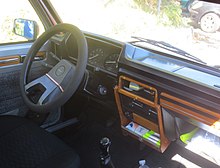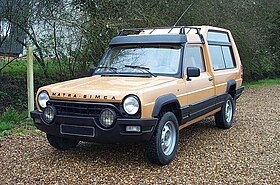auto.wikisort.org - Automobile
The Matra Rancho is a leisure activity vehicle created by the French engineering group Matra, in cooperation with the automaker Simca, to capitalize on the off-road trend started by the Range Rover. The Rancho provided an "off-road look" at a lower price.



| Matra Rancho | |
|---|---|
 | |
| Overview | |
| Manufacturer | Matra |
| Also called | Matra-Simca Rancho (1977-1979) Talbot Matra Rancho (1980-1984) Matra-Simca and Talbot-Matra Ranch for Italian market |
| Production | 1977–1984 |
| Designer | Antonis Volanis |
| Body and chassis | |
| Class | Leisure activity vehicle |
| Body style | 3-door estate |
| Layout | FF layout |
| Related | Simca 1100 |
| Powertrain | |
| Engine | 1.4 L Type 315 ohv I4 |
| Transmission | 4-speed manual |
| Dimensions | |
| Wheelbase | 2,520 mm (99.2 in)[1] |
| Length | 4,315 mm (169.9 in)[1] |
| Width | 1,665 mm (65.6 in)[1] |
| Height | 1,735 mm (68.3 in)[1] |
| Curb weight | 1,130 kg (2,491 lb)[1] |
The Rancho was launched in 1977, and became a popular model, but this did not alleviate larger problems at Chrysler Europe (Simca's parent company). Chrysler finally sold its European arm to PSA in 1978, which was then rebranded as Talbot in 1979. The Matra-Simca Rancho became the Talbot Matra Rancho and production continued until 1984 (although it remained on sale up to January 1985), reaching 57,792 cars in total.[2]
Designed by Antonis Volanis, the Rancho was based on the pick-up version of Simca's popular supermini, the Simca 1100, using its front structure and a stretched chassis. The rest of the body was made by Matra from fibreglass and polyester, including the mouldings adorning the body, which made it look more "sturdy". This technology would later be used on the Renault Espace, Europe's first MPV, which was manufactured by Matra. The ground clearance was also increased. Unlike most off-roaders, it was not fitted with all-wheel drive, retaining the 1100s front-wheel drive layout. Other elements retained from the 1100 included the dashboard and front seats (identical to the ones found in the Simca 1100 GLS). The Rancho was powered by the 1,442 cc, 80 bhp version of the "Poissy engine" straight-four engine.[2]
During its life, the Rancho was offered in several versions. Apart from the basic Rancho, there was the Grand Raid, fitted with such off-road extras as an electric winch on the front bumper and an extra spare wheel mounted on the roof - as well as a limited-slip differential. It also received undercarriage protection, bronze tinted windows, and was only available in a matte green colour.[3] The Rancho X was the upscale model, with additional standard items such as alloy wheels and metallic paint. The Découvrable model's rear cabin consisted of an open frame with roll-down fabric covers, which could serve as an "open" car during good weather. Finally, the Rancho AS was the commercial version, with no rear seat, making it exempt from the French tax on passenger cars.[2]
The Rancho spawned an unlikely successor: the Renault Espace. Matra wanted to replace the Rancho with their prototype of the Espace known as the “dessin orange”, which translates to “the orange drawing” in English – both the prototype and the background it was drawn on were orange. It predicted the basic shape of the first Espace but only had three doors instead of five. Peugeot (who controlled Matra at the time) deemed the project too expensive and not promising enough. Determined to take its design to production Matra knocked on Renault's door and they quickly adopted the project, one that upon its launch in 1984 arguably became the first European minivan.[4]
References
- G.L. (25 May 1977). "Feldjäger: Neues Geländeauto aus Frankreich: Matra Simca Rancho" [Field Huntsman: New off-roader from Germany]. Auto, Motor und Sport (in German) (11): 46–50.
- "Talbot Matra Rancho". Simca Talbot Information Centre – Simca Club UK. Retrieved 2006-08-23.
- Costa, André & Georges-Michel Fraichard, ed. (September 1979), "Salon 1979: Toutes les Voitures du Monde", L'Auto Journal (in French), Paris: Homme N°1 (14 & 15): 109
- "A quick look at the Matra-Simca Rancho". www.ranwhenparked.net. Archived from the original on 2012-03-26.
External links
- Matra-Simca Rancho at matrasport.dk
- The Matra Rancho: Chrysler Europe’s Car-Based SUV at allpar.com
- SIMCA Club UK
На других языках
[de] Talbot-Matra Rancho
Der Talbot-Matra Rancho, ursprünglich Matra-Simca Rancho, war ein Freizeitfahrzeug des Automobilherstellers Talbot. Das Modell auf Basis des Simca 1100 Pick-up wurde 1976 im Matra-Planungsbüro von Antonis Volanis entworfen. Man entwickelte den Simca durch Anbauteile aus glasfaserverstärktem Kunststoff zu einem nach Geländewagen aussehenden Freizeitauto. Der Simca Poissy-Motor war der gleiche wie im Simca 1308 oder Talbot 1510 und leistete 80 PS (59 kW). Der ursprünglich geplante Allradantrieb erschien den Verantwortlichen jedoch zu teuer, so dass man es schließlich bei Frontantrieb beließ.- [en] Matra Rancho
[es] Matra Rancho
El Matra Rancho es un automóvil todoterreno creado por el grupo francés Matra en cooperación con Simca para liderar la tendencia todoterreno empezada por el Range Rover, pero a un precio inferior. Se presentó en 1977 y se convirtió en un modelo muy popular, pero no ayudó a subsanar los problemas de la marca madre Chrysler de aquella época. Al final se optó por vender la rama europea de Chrysler a PSA en 1978, que decidió renombrar todos los antiguos modelos bajo la marca Talbot desde 1979. La producción continuó hasta 1984 y se completaron 57.792 unidades.[fr] Matra-Simca Rancho
La Rancho est une voiture polyvalente et originale, conçue et produite par Matra, et commercialisée sous la marque Matra-Simca.[it] Matra-Simca Rancho
La Matra-Simca Rancho o Ranch è un'autovettura prodotta dal 1977 al 1984 dalla Casa automobilistica francese Matra.[ru] Talbot Matra Rancho
Автомобиль Talbot Matra Rancho AS, выпущенный автомобильным отделением аэрокосмической фирмы Matra, впервые был показан публике в 1977 году. В 1981 году появилась версия с открытым верхом.Другой контент может иметь иную лицензию. Перед использованием материалов сайта WikiSort.org внимательно изучите правила лицензирования конкретных элементов наполнения сайта.
WikiSort.org - проект по пересортировке и дополнению контента Википедии